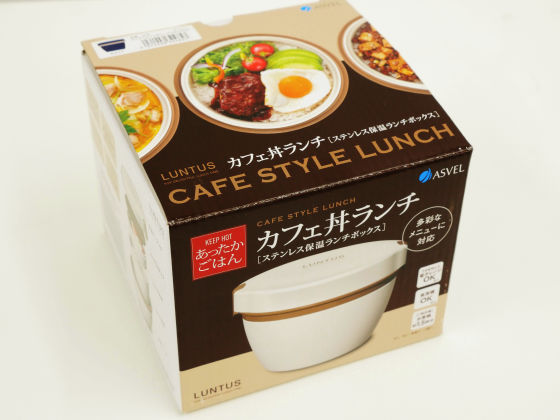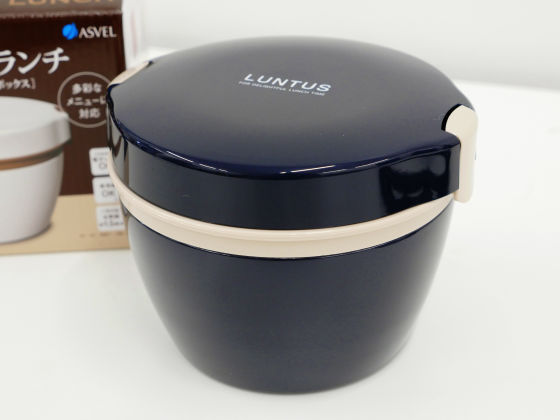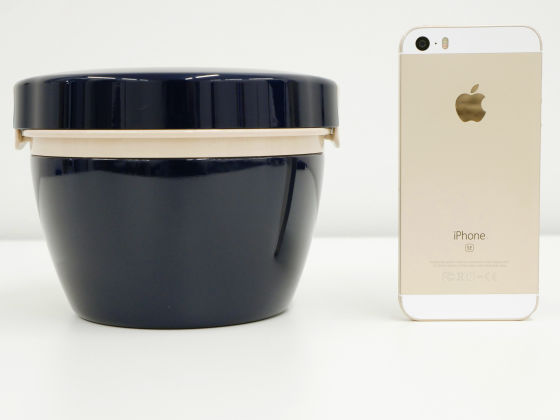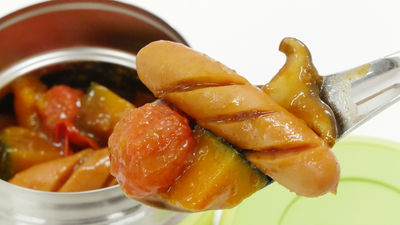Review of 'Lantas Cafe Bowl Lunch' where you can eat rice bowls and curry in a hot state with a lunch box

Some people are starting a new life and are forced to make a bento for lunch. A cold bento is delicious, but if possible, I would like to eat something warm. For those who want to eat something warm, Asvel's bento box ' Lantas Cafe Don Lunch ' is a lunch box with a heat retention function that allows you to eat curry donburi in a warm state, so I actually tried using it.
[Rakuten Market] Lunch Box Lunch Box Insulated Lunch Box [Next Day Delivery] Cafe Bowl Lunch HLB-CD620: Asvel Rakuten Market Store for Household Goods
This is the 'Lantas Cafe Bowl Lunch' package.

Inside was a lunch box like this.

The size is 14.5 cm wide x 13.8 cm deep x 11.0 cm high. It weighs 600 g, which is about the same as the iPhone SE, which is 124.8 mm long.


This is how it looks compared to the 0.38L Thermos Vacuum Insulated Food Container . It is wide and has a bowl-like shape.


The thermal case is made of stainless steel (with acrylic resin coating) and the lid is made of polypropylene (inner material: expanded PP insulation). When you open the lid of the thermal case, you will see containers for rice and side dishes.

The inner container is divided into a side dish container and a rice container.

The side dish container has a capacity of 310 ml, is made of polypropylene, and has a silicone rubber lid.

The rice container has a capacity of 310ml and is also made of polypropylene.

So I'll try using the lunch box. The Lantas Cafe Donburi Lunch is characterized by the fact that in addition to the usual side dishes, you can also eat curry and rice bowls as a lunch box, so I tried making an oyakodon. Since it's for a lunch box, I cooked it thoroughly.

Rice containers have a line indicating the maximum capacity, so be sure not to exceed that line. It should hold about 200g, or about the same amount as a large bowl.

Place the oyakodon ingredients in the side dish container.

The package said, 'Just before you leave, put rice into the rice container and heat in the microwave without the lid on,' so I heated the rice at 800W for about a minute.

When I used the

The temperature of the oyakodon ingredients was 50.9 degrees at this time.

Put the rice and side dishes into a container that has been warmed with hot water, and quickly close the inner and outer lids...

Leave it in a 22 degree room for 6 hours.

After 6 hours, open the lid...

When I took the temperature, the rice was 39.8 degrees.

The ingredients in the oyakodon were 34.9 degrees.

When I tried it, the ingredients in the oyakodon were at a temperature lower than body temperature, so my honest impression was that it was a little lukewarm and starting to cool down. I had hoped that the bento I made in the morning would be piping hot when I ate it at lunchtime, so this wasn't quite what I had hoped for, and I was disappointed.

What kind of condition would allow me to eat a hot lunch? So I tried various experiments. I made Oyakodon again...

The instructions on the package said to microwave only the rice before placing it in the insulated container, but I also tried microwaving not only the rice but also the ingredients for the oyakodon until they were boiling.

In this state, the temperature of the rice just before being placed into the insulated container is 84 degrees, and the temperature of the oyakodon ingredients is 79.3 degrees.


After six hours, the temperature of the rice was 44.1°C and the temperature of the oyakodon ingredients was 40.0°C.


The 5 degree temperature difference was larger than expected, and it felt a little warm at this temperature. 35 degrees was the least suitable temperature for a bento out of all the ones I ate this time, and it was a 'disgusting' temperature to eat, but if it had risen to around 40 degrees, it could have just about been called a 'warm bento'. But to be honest, I wish it had been a little warmer!

So, I decided to try out the extra heat retention function by using the special thermal bag that comes with the Lantas Cafe Bowl Lunch.

After cooking the oyakodon, the rice and ingredients are heated at 800W and quickly placed in the lunch box, just like before. However, the lunch box is then placed in an insulated bag and left in a room at 22 degrees for six hours.

The temperatures of the rice and ingredients just before packing them into the lunch box were 84.4 degrees and 78.7 degrees, respectively.


After six hours the temperatures were 46.5°C and 44.2°C.


When I actually tried it, it wasn't piping hot, but it was still warm enough to be called a 'warm lunch.' It would be useful even if you leave home at 7am and eat lunch at 1pm.

By the way, when I shortened the time to four hours under the same conditions as above, the temperature of the rice exceeded 50 degrees, so I could eat a hotter rice bowl for lunch. In other words, a prerequisite for using the Lantas Cafe Donburi Lunch is that you have a microwave at home . If you keep it hot, put it in the case, use the special cover, and leave the house at 8am and eat lunch at 12pm, it's even better.


In addition to rice bowls, I also tried it with hamburgers and other dishes...

I heated it at 800W for one minute before putting it in the lunch box, and left it in a warming case in a room at 22°C for four hours, and was able to eat rice that was over 50°C. The temperature may vary depending on the room temperature and the contents and amount of the side dishes, but it looks like side dishes other than rice bowls will stay warm for up to four hours.


By the way, the surface of the lunch box is somewhat prone to scratches, so care should be taken when handling it.

In addition, the Lantas Cafe Bowl Lunch can be purchased at Asvel's Rakuten shop for 1,980 yen including tax. If it comes with a thermal bag, it is 2,780 yen including tax.
[Rakuten Ichiba] Lunch Box Lunch Box Insulated Lunch Box 1. Cafe Bowl Insulated Lunch HLB-CD620 [Insulated Bag for Cafe Bowl]: Asvel Rakuten Ichiba Store for Household Goods
http://item.rakuten.co.jp/asvel/3248-set2/

Related Posts:







